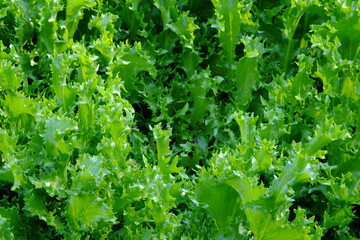Endive and Escarole Water Requirements & Irrigation Systems
How much Water does Endive and Escarole need?
Despite their shallow root system, endives and escaroles can generally withstand some drought and are generally more heat tolerant than lettuce. However, the yield and quality of the final product (level of bitterness and leaf tenderness) will be significantly decreased under water-stressed conditions. Moreover, such stressful conditions may initiate bolting.
The crop needs approximately 8-12 inches (203-305 mm) of water throughout the growing season. Most growers irrigate their plants frequently, providing 1-1.5 inches (25-38 mm) of water weekly. In sandy soils, there might be a need to break this amount into more than one application to decrease the risk of water loss. Remember that 1 inch of water is sufficient to wet the upper 10 cm (4 in) of sandy soil (6 cm or 2.3 in clay soil). Many farmers apply mulch between plants’ rows to reduce evaporation and maintain soil moisture. The total and weekly amount of water added with irrigation may vary depending on the environmental conditions and planting date (rainfalls, temperatures, etc.), the variety, and plant density. It is vital to avoid extended dry spells and water with adequate water afterward since this can lead to the browning of the leaves. Finally, farmers often apply irrigation sessions until harvest. These last few irrigations can improve the crispiness of the endive’s leaves.
Endive and Escarole Irrigation Systems
Furrow irrigation can also be used when endives are cultivated in single or double-row beds. The most commonly used irrigation system is drip irrigation. Most producers use multiple or one-use drip strips with a 20 cm (7.8 inches) distance between drips. This technique is more popular and advised to be used in light soils to decrease water runoff. Finally, endives and escaroles can be watered with sprinkler irrigation. Based on scientific evidence, this technique has been proven helpful for cooling the canopy of endive plants and reducing tip burn in areas where the temperature exceeds 28°C (80°F). However, if fungal diseases pose a significant problem in a specific region/field, the farmers are advised to avoid using overhead irrigation.
Further Reading
10 Interesting Facts about Endive and Escarole
Endive and Escarole: Health Benefits and Nutritional Value
Endive & Escarole Plant Information and Environmental Requirements
How to Grow Endive (and Escarole) at Home
How to Grow Endive -Escarole for Profit
Endive (and Escarole) Soil Requirements, Preparation and Planting
Endive and Escarole Water Requirements & Irrigation Systems
Endive and Escarole Fertilization Requirements
Endive and Escarole Blanching, Yield, Harvest and Storage
Endive and Escarole Pests and Diseases
References










































































